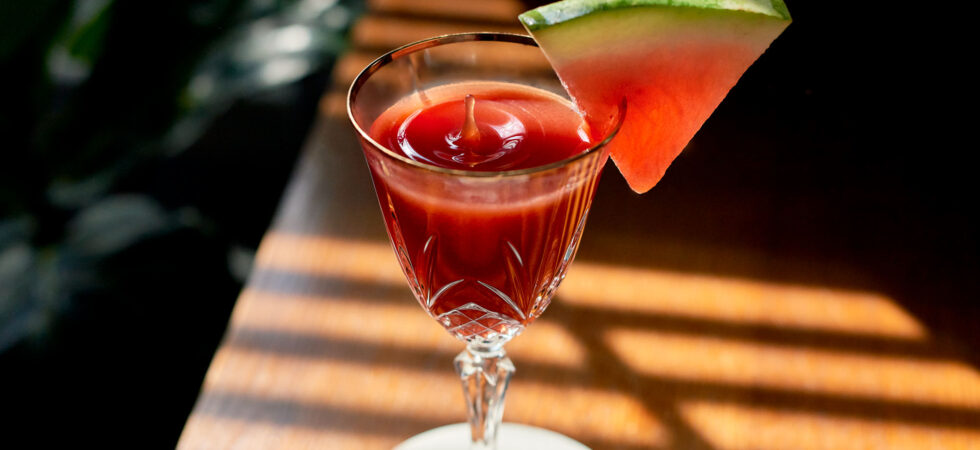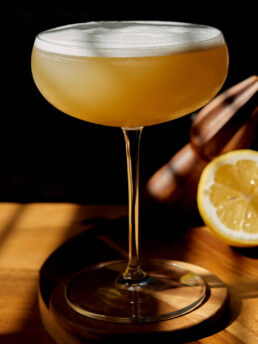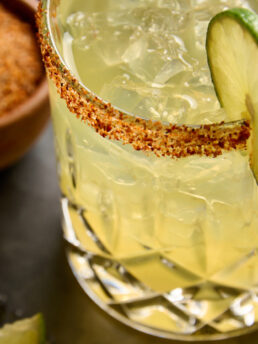Watermelon-Tamarind Cognac Cocktail

A new summer sipper has entered the chat. This Watermelon-Tamarind Cognac cocktail is everything you could want during the peak of seasonal heat waves. Even better, you can serve it sans alcohol for the kiddos. Everyone wins!

Get the Recipe: Watermelon-Tamarind Cognac Cocktail
Ingredients
Triple Simple Syrup
- ¼ cup granulated sugar
- ¼ cup water
- 1½ oz agave syrup
- ¾ oz honey
Watermelon-Tamarind Cognac Cocktail
- 1½ oz cognac
- 4 oz (roughly 1c cubed watermelon) fresh watermelon juice
- ½ oz fresh lime juice, (about 1/2 a lime)
- 1 oz triple syrup
- ½ oz Tamicon tamarind concentrate
Equipment
- 1 Small Sauce Pot
- 1 spatula
- 1 chef knife
- 1 cutting board
- 1 muddler or blender
- 1 Fine Mesh Strainer
- measuring Cups
- 1 cocktail shaker
Instructions
Triple Simple Syrup
- First, make the syrup. Add water and sugar to a small saucepan over medium heat. Stir until the sugar is dissolved. Turn off the heat and after about 10 minutes, pour the simple syrup into a heatproof container along with the agave and honey and mix to make the triple syrup. Put it in the refrigerator or freezer to chill while you prep the other ingredients.
Watermelon-Tamarind Cognac Cocktail
- Juice the lime and set the liquid aside. Then, cut up the watermelon into manageable chunks. Add the watermelon pieces to a cup or a blender, and either muddle or blend on low. Use a strainer, to separate the watermelon juice from the pulp. Keep the watermelon juice and toss the rest.
- Next, measure out and add all of the ingredients to a cocktail shaker. Top with ice, close the shaker, and vigorously shake everything for about 30-45 seconds. Strain into either a coupe glass (sans ice) or into a highball (with ice). Garnish with a watermelon wedge, lime wedge, or sprig of slapped mint.
Notes
- The triple simple syrup recipe makes enough for 6-7 cocktails, in case you want to make a big batch and chill everything ahead of time.
- The syrup can also be made ahead, and it lasts up to 3 weeks when refrigerated.
- If you want to make a larger batch of Triple Simple Syrup, the ratio is 1 part simple syrup (water+sugar) : 1/2 part agave : 1/4 part honey. I do this by weight, but it’s a huge debate whether weight or volume is correct. Either way works. Do what’s easiest for you.
- The larger the ice cube(s) you use when shaking the less watered down your drink will be as there is less surface area. No crushed during shaking please.
- Turn this into a non-alcoholic summer punch or mocktail by taking out the alcohol and the lime juice and adding in the difference by volume in soda water or tonic.
- I used an OX Cognac for this cocktail, but other styles can be used. (see FAQs)
Nutrition

Frequently Asked Questions
I’m not sure what kind of tamarind products everyone will have access to locally, so here’s the deal… I’ve linked the tamarind concentrate I use here, so you can purchase it through Amazon. (I’m not sponsored. This is what I use at home.) At the very least you can see a picture of the label, so you know what to buy in an Asian, South Asian, Indian, or Middle Eastern market – depending on how your local markets categorize themselves or what they stock. I’ve seen it in all of these markets.
While I do recommend tamarind concentrate, for ease of use and sharp flavor, you may only find tamarind paste in stores. This comes either with seeds or seedless. The paste will definitely still work for this cocktail, but you will need to do a few additional steps.
Yep. 🙂 There are two types of paste, seedless and seeded.
1. If you use seedless paste, pack the paste into about 1½ tablespoons or weight out 20g. Then, drop it into a blender with the watermelon juice (not chucks, this is after you strain), triple simple syrup, and lime juice. Mix until it’s as incorporated as you can get it. There might be some clumped tamarind pulp in the mix. That’s okay. Strain everything through a fine mesh strainer into your shaker and add in the cognac. Shake the cocktail and give it a taste to decide if you need a little extra lime juice (tamarind paste isn’t quite as tangy as the concentrate, so this is probably a given depending on your tastes). I increase the lime to 1oz (30ml) when I use paste.
2. If you use a paste that has seeds, you still need to do the same thing, but you need to remove the seeds from the paste before you measure/weigh. They are quite large, so it won’t be difficult to find them amidst the paste, but it can be a sticky endeavor. (Don’t roll your eyes! I guarantee you someone would ask this question wanting to make sure they were doing things right… Also, yes, it’s me. I am that person.)
Aside from the watermelon wedge? You have a few options…
1. Lime wheel: This is an easy, go-to option. Cut a slice from the midsection of the other side of the lime (not used for lime juice in the recipe) and make a small radial cut into the slice. Then slip it onto the side of your glass.
2. Fresh mint sprig: If you want to garnish with mint, take a sprig and slap it against the back of your hand to release the oils. Drag the mint around the outside rim of the cup and then insert it into the ice.
3. Tajin rim: If you’d like a tajín rim, before you chill the glass, paint the rim with a thin layer of the triple simple syrup. Then rotate the glass into the tajín.
Of Note: Trying to rim the glass after it’s been chilled will take too much time and reheat the glass. And, as the glass reheats, moisture (that’s not sticky) will collect and stop the tajín from sticking.
Sure are. Consider the following criterion:
– Sound – Pick up your watermelon and give it a thump. Don’t be scared of your food. It’s really important to touch/handle your produce before buying it. Hold the watermelon with one hand underneath and knock the top with your other hand. An under-ripe watermelon will give a “plink” higher-pitched, muffled sound. A ripe watermelon will have a “plunk” lower-pitched, deep sound because of the increased water content and less fibrous core. Rap a few melons and choose the one that thuds.
– Shape – A symmetrical watermelon is more likely to be evenly ripe. Try to find something that isn’t oddly shaped, lumpy, or dented.
– Weight – A good watermelon is going to be heavier than it looks. Water weighs more than air (it’s science!) So, the heavier the melon. the more water content within.
– Field Spots – Watermelons that ripen on the ground will have a field spot. The more ripe the watermelon, the deeper in color the field spot will be. Creamy yellow or deep yellow spots, indicate that a watermelon is fully ripe, sweet, and ready to eat. Light green or white spots mean the fruit might not be ready. If the watermelon varietal has pronounced stripes, you also shouldn’t be able to see any of them through the field spot.
– Rind Appearance – The cuticle is a natural waxy coating covering the rind that protects the watermelon as it grows. It helps retain moisture and protect against pests. As a watermelon ripens this coating will begin to degrade, giving it a matte appearance. Less shine equates to a sweeter melon.
– Rind Firmness – The watermelon shouldn’t have any mushy or bruised spots. If you can push into the rind, it’s over-ripe or might have damaged meat inside. At the same time, if the watermelon feels like it’s made of stone, it may be under-ripe.
Cognac is brandy. But… think of Cognac like you think of Champagne. All Cognac is brandy but not all brandy is Cognac.
Cognac is a variety of brandy crafted in the Cognac region of France. (France loves an exclusive). It is almost soley (98% of the region’s acreage) made from the Ugni Blanc grape, also known as Trebbiano, though Folle Blanche and Colombard can also be used.
Cognac goes through a double distillation process, first in copper stills and then in oak barrels (typically French), to impart its signature amber color as well as it’s vanilla, caramel, and dried fruit flavors. The spirit resulting from the first distillation is referred to by the French as eau-de-vie or “water of life,”. (Any Dune fans loving this fact?) This first distillate must age for a minimum of 2 years before I can be called cognac.
WordPress won’t let me add integrated footnotes to FAQ blocks, so here’s the referenced article for this question and the next one as well!
Mytnikova, Renata. “The Quick Guide to Great Cognac.” Wine Folly, https://winefolly.com/deep-dive/the-guide-to-cognac/.
Classification of Cognac is determined classically by its age, much like tequila. Here are the categories:
– VS (Very Special): Aged for at least 2 years.
– VSOP (Very Superior Old Pale): Aged for at least 4 years.
– Extra: Aged for at least 6 years.
– XO (Extra Old): Aged for at least 10 years, with some bottles containing much older blends. (Previous to 2018, this had a 6-year requirement.)
– Hors d’âge or Heritage: Often exceeds the XO aging requirements by quite a bit, think 40 or more years!
I’m going to let you in on a secret. I use Kirkland (Costco) brand XO Cognac. And, while I wouldn’t consider it a high-end Cognac (even with the XO label), it’s a great price point for an XO and it’s a great bang for your buck.
If you are looking to reproduce this cocktail exactly, you know what to do.
If you want to search for a Cognac on your own. Look for these tasting notes:
citrus zest, dried apricot, hints of honey, chocolate and almond with a lightly spiced, soft molasses finish. (Sounds delicious, no?)



